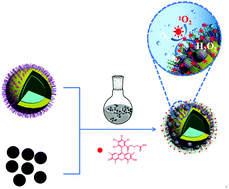当前位置:
X-MOL 学术
›
Inorg. Chem. Front.
›
论文详情
Our official English website, www.x-mol.net, welcomes your feedback! (Note: you will need to create a separate account there.)
Surface ligand coordination induced self-assembly of a nanohybrid for efficient photodynamic therapy and imaging†
Inorganic Chemistry Frontiers ( IF 7 ) Pub Date : 2018-09-04 00:00:00 , DOI: 10.1039/c8qi00777b Pingru Su 1, 2, 3, 4, 5 , Zhanwu Zhu 4, 5, 6, 7, 8 , Qiaohui Fan 5, 8, 9, 10 , Jing Cao 1, 2, 3, 4, 5 , Yuepeng Wang 1, 2, 3, 4, 5 , Xiaoxi Yang 1, 2, 3, 4, 5 , Bo Cheng 4, 5, 6, 7, 8 , Weisheng Liu 1, 2, 3, 4, 5 , Yu Tang 1, 2, 3, 4, 5
Inorganic Chemistry Frontiers ( IF 7 ) Pub Date : 2018-09-04 00:00:00 , DOI: 10.1039/c8qi00777b Pingru Su 1, 2, 3, 4, 5 , Zhanwu Zhu 4, 5, 6, 7, 8 , Qiaohui Fan 5, 8, 9, 10 , Jing Cao 1, 2, 3, 4, 5 , Yuepeng Wang 1, 2, 3, 4, 5 , Xiaoxi Yang 1, 2, 3, 4, 5 , Bo Cheng 4, 5, 6, 7, 8 , Weisheng Liu 1, 2, 3, 4, 5 , Yu Tang 1, 2, 3, 4, 5
Affiliation

|
Nanohybrids have greatly promoted the application of nanomaterials in real world problems, since they not only present the individual advanced properties of each material, but can also realize the amplification of the functions of the combined materials. Here, we assembled up-conversion nanoparticles NaYF4,Yb/Er@NaYF4 (UCNPs) and MnFe2O4 (MF) into a multi-functional nanohybrid through direct coordination using polyacrylic acid (PAA) as the surficial bridging linker. Afterwards, the photosensitizer molecules Rose Bengal (RB) and PEG-COOH were covalently grafted onto the nanohybrid. UCNPs effectively stimulated RB by means of fluorescence resonance energy transfer effects to convert O2 to 1O2. Meanwhile, the MF NPs worked as a Fenton catalyst to continuously generate O2 by decomposing H2O2 in the H2O2 over-expression tumor micro-environment. Thus, a comprehensive therapeutic system was successfully constructed, which can efficiently perform photodynamic therapy (PDT) of hypoxic tumors under the excitation of a 980 nm laser. This work explored a new method for the assembly of nanohybrids using heterogeneous nanomaterials by coordination with bridging ligands between NPs and provided a versatile PDT candidate for hypoxic tumors.
中文翻译:

表面配位体配位诱导纳米杂化物的自组装,以进行有效的光动力学治疗和成像†
纳米混杂物不仅极大地促进了每种材料各自的先进性能,而且还可以实现复合材料功能的放大,因此极大地促进了纳米材料在现实世界中的应用。在这里,我们通过使用聚丙烯酸酯(PAA)作为表面桥联连接剂的直接配位,将上转换纳米颗粒NaYF 4,Yb / Er @ NaYF 4(UCNPs)和MnFe 2 O 4(MF)组装成多功能纳米杂化物。之后,将光敏剂分子Rose Bengal(RB)和PEG-COOH共价接枝到纳米杂化物上。UCNP通过荧光共振能量转移效应有效地刺激了RB,将O 2转化为1O 2。同时,MF NPs作为Fenton催化剂,通过在过表达的H 2 O 2肿瘤微环境中分解H 2 O 2来连续产生O 2。因此,成功构建了一个综合的治疗系统,该系统可以在980 nm激光的激发下有效地进行缺氧性肿瘤的光动力治疗(PDT)。这项工作探索了一种新的方法,通过与NP之间的桥连配体配合使用异质纳米材料组装纳米杂化物,并为缺氧肿瘤提供了一种多功能的PDT候选物。
更新日期:2018-09-04
中文翻译:

表面配位体配位诱导纳米杂化物的自组装,以进行有效的光动力学治疗和成像†
纳米混杂物不仅极大地促进了每种材料各自的先进性能,而且还可以实现复合材料功能的放大,因此极大地促进了纳米材料在现实世界中的应用。在这里,我们通过使用聚丙烯酸酯(PAA)作为表面桥联连接剂的直接配位,将上转换纳米颗粒NaYF 4,Yb / Er @ NaYF 4(UCNPs)和MnFe 2 O 4(MF)组装成多功能纳米杂化物。之后,将光敏剂分子Rose Bengal(RB)和PEG-COOH共价接枝到纳米杂化物上。UCNP通过荧光共振能量转移效应有效地刺激了RB,将O 2转化为1O 2。同时,MF NPs作为Fenton催化剂,通过在过表达的H 2 O 2肿瘤微环境中分解H 2 O 2来连续产生O 2。因此,成功构建了一个综合的治疗系统,该系统可以在980 nm激光的激发下有效地进行缺氧性肿瘤的光动力治疗(PDT)。这项工作探索了一种新的方法,通过与NP之间的桥连配体配合使用异质纳米材料组装纳米杂化物,并为缺氧肿瘤提供了一种多功能的PDT候选物。



























 京公网安备 11010802027423号
京公网安备 11010802027423号